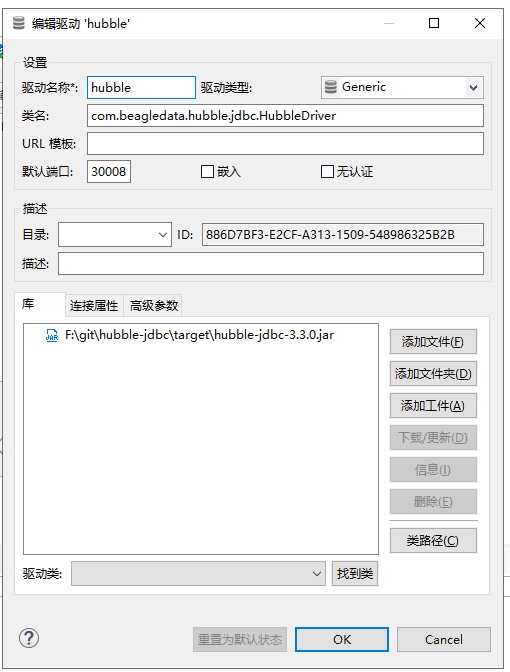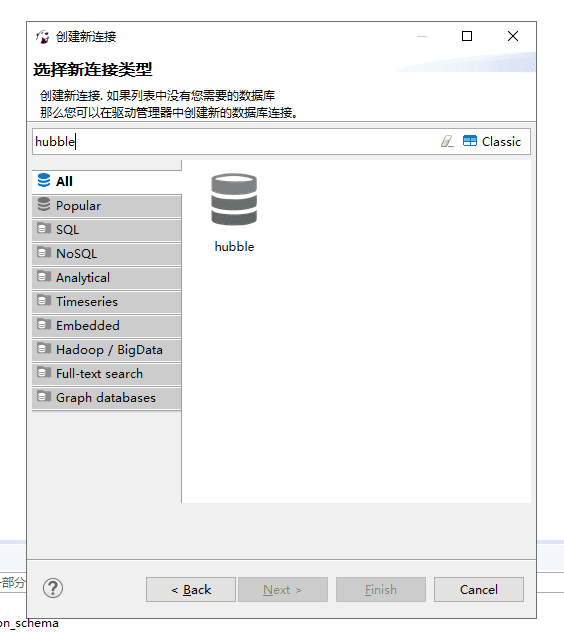使用操作
交互方式
Hubble的交互方式有命令行方式和jdbc方式两种。
命令行方式
在hubble的bin目录下,脚本程序hubble-sql.sh启动cli。
有用的参数有:
--catalog <catalog> 进入hubble命令行的默认catalog
--database <database> 进入hubble命令行的默认database
-e <execute> 使用-e后边跟SQL进行查询,用引号将需要执行的SQL包起来
-f <file> 使用-f后边跟文件进行查询
--server <server> hubble提供服务的地址
--user <user> hubble的用户名
--password <password> hubble的密码
--hubvar<name> 外部输入参数名称
--output-format <output-format> 执行查询输出的格式,包括ALIGNED, VERTICAL, JSON, CSV, TSV,CSV_HEADER, CSV_UNQUOTED,CSV_HEADER_UNQUOTED等格式,默认CSV格式输出例如
1.在命令行下执行查询:
bin/hubble-sql.sh --server=hubble01:30008 --user=hubble
hubble-cli> show catalogs;
+---------+
| Catalog |
+---------+
| hubble |
| system |
+---------+
(4 rows in set)
2.47 sec2.使用-e参数查询:
bin/hubble-sql.sh --server=hubble01:30008 --user=hubble -e "show catalogs"
"hubble"
"system"3.使用-f参数查询:
新建文本showcata.sql
内容show catalogs
bin/hubble-sql.sh --server=hubble01:30008 --user=hubble -f showcata.sql
"hubble"
"system"4.使用-hubvar参数查询:
使用语法:
bin/hubble-sql.sh --server= ip+端口 --user=用户 --catalog=catalog数据源 --password
--execute"slect * from tablename where column='\${hubvar:参数名称}' "
--hubvar "参数名称=xx"数据样例
f1 | f2 | f3
----+----+----
l | 18 | 男
c | 20 | 男
w | 22 | 女 样例: 查询表t12的内容f1字段判断条件通过hubvar传递
[hubble@hubble01 bin]$./hubble-sql.sh --server=https://hubble01.hubbledb.cn:7077 --user=hubble --catalog=hubble --password
--execute "select * from hubble.test.t12 where f1 ='\${hubvar:a}'" --hubvar "a=l";
--返回查询结果
"l","18","男 " 注意: 使用命令行传参时需要加转义符号\ 并且 ''单引号不是${hubvar:name}中参数具体看字段类型
样例: 使用多个传递参数
[hubble@hubble01 bin]$ ./hubble-sql.sh --server=https://hubble01.hubbledb.cn:7077 --user=hubble --
catalog=hubble --password --execute "select * from hubble.test.t12 where \${hubvar:a} ='\${hubvar:b}'
" --hubvar "a=f1" --hubvar "b=l" ;
--返回查询结果
"l","18","男 " -f命令执行sql文件并使用hubvar传递参数
使用语法:
#client参数配置
bin/hubble-sql.sh --server= ip+端口 --user=用户 --catalog=catalog数据源 --password
-f 调用sql文件名称
--hubvar "参数设置名称=xx"
#sql文件中配置
select * from tablename where cloumn ='${hubvar:xxx}' 样例: 使用-f 命令查询a.sql 并使用hubvar传递文件中参数
创建a.sql文件
select * from hubble.test.t12 where f1 ='${hubvar:a}' and f2=${hubvar:b};注意: sql文件调用时不需要加转义符\
执行命令调用a.sql
[hubble@hubble01 bin]$ ./hubble-sql.sh --server=https://hubble01.hubbledb.cn:7077 --user=hubble --catalog=hubble --password -f a.sql --hubvar "a=c" --hubvar "b=20";
--返回查询结果
"c","20","男 " 5.用户密码认证
[hubble@hubble01 hubble-5.2.1]$ export HUBBLE_PASSWORD=hubble; bin/hubble-sql.sh --server=https://hubble01.hubbledb.cn:33484 --user=hubble --password
Password:
hubble> show schemas in hubble;
Schema
--------------------
default
information_schema
(2 rows)
Query 20230329_060232_00000_rnitj, FINISHED, 5 nodes
Splits: 87 total, 87 done (100.00%)
4.01 [2 rows, 35B] [0 rows/s, 9B/s]
hubble> create schema hubble.zl;
注意:
用户密码认证 需要通过https 方式访问
export HUBBLE_PASSWORD 设置密码
server 指定master 域名
JDBC方式-无认证
使用Hubble JDBC驱动提供JDBC方式访问Hubble。
包括两种:写JDBC程序,导入JDBC驱动来访问。使用dbeaver等通用数据库端工具的方式进行访问。
代码方式
java方式
url可以是下列中的任一种:
jdbc:hubble://host:port
jdbc:hubble://host:port/<catalog>
jdbc:hubble://host:port/<catalog>/<database>catalog及shema为可选项。可以限定jdbc程序默认连接的catalog和database。
在项目中导入jdbc驱动包,并创建下面的类:
package com.beagledata.hubble.hubblejdbc;
import java.sql.Connection;
import java.sql.DriverManager;
import java.sql.ResultSet;
import java.sql.SQLException;
import java.sql.Statement;
public class JdbcTest {
private static final String JDBC_URL = "jdbc:hubble://master:30008/hubble/tpcds";
private static final String username = "hadoop";
public static void main(String[] args) {
try {
Class.forName("com.beagledata.hubble.jdbc.HubbleDriver");
try(Connection conn = DriverManager.getConnection(JDBC_URL, username, null);
Statement stmt = conn.createStatement()){
ResultSet res = stmt.executeQuery("select * from tpcds.lineitem limit 20");
int col = res.getMetaData().getColumnCount();
while (res.next()) {
for (int i = 1; i <= col; i++) {
System.out.print(res.getString(i) + "\t");
if ((i == 2) && (res.getString(i).length() < 8)) {
System.out.print("\t");
}
}
System.out.println("");
}
}
} catch (ClassNotFoundException | SQLException e) {
e.printStackTrace();
}
}
}运行,即可查询出tpcds库下的lineitem表中的数据。
使用hubvar调用参数
package com.zendesk.maxwell.util;
import java.sql.Connection;
import java.sql.ResultSet;
import java.sql.SQLException;
import java.sql.Statement;
import java.util.Properties;
import com.beagledata.hubble.jdbc.HubbleDriver;
public class HubbleDemo {
public static void main(String[] args) {
String sql="select * from hubble.default.t7 where nmae='${hubvar:nmae}'";
try {
testconnection1(sql);
} catch (ClassNotFoundException e) {
// TODO Auto-generated catch block
e.printStackTrace();
} catch (SQLException e) {
// TODO Auto-generated catch block
e.printStackTrace();
}
}
public static void testconnection1(String sql) throws ClassNotFoundException, SQLException {
Class.forName("com.beagledata.hubble.jdbc.HubbleDriver");
Properties pro = new Properties();
String url= "jdbc:hubble://192.168.100.123:7077";
HubbleDriver hubbleDriver =new HubbleDriver();
pro.put("user", "hubble");
pro.put("hubvar:nmae", "a3");
Connection conn=hubbleDriver.connect(url, pro);
Statement stmt = conn.createStatement();
ResultSet re=stmt.executeQuery(sql);
while(re.next()) {
System.out.println(re.getString(1));
}
stmt.close();
conn.close();
}
}python方式
导入的Hubble包需要找相关工作人员获取
# coding:utf8
import hubble
conn = hubble.dbapi.connect(
host='192.168.100.134',#主机IP
port=20088,#数据库端口为启动端口
user='hubble',#用户
catalog='hubble',#指定数据源
schema='test'# 库名
)
cur = conn.cursor()
# ----------------------- sql 查询 -------------------------------
sl_sql="""select * from hubble.test.t_test2 limit 1 """
cur.execute(sl_sql)
#获取每一行,可选其他参数:fetchone获取一行
rows = cur.fetchall()
# 显示每列的详细信息
des = cur.description
print("表的描述:", des)
# 获取表头
print("表头:", ",".join([item[0] for item in des]))
print(rows)
conn.close()
cur.close()插入数据
import hubble
from hubble import transaction
with hubble.dbapi.connect(
host='192.168.100.134',#主机ip
port=20088,#数据库端口
user='hubble',#用户名
catalog='hubble',#数据源
schema='test',#库名
isolation_level=transaction.IsolationLevel.REPEATABLE_READ,#开启事物
) as conn:
cur = conn.cursor()
#------------------------------------insertsql-----------------------------------
ins_sql="""INSERT INTO hubble.test.t_test2 VALUES (1, '2', '3')"""
cur.execute(ins_sql)
cur.fetchall()
#释放资源
caonn.close()
cur.close()通用客户端方式
1.使用DBeaver进行连接。
下载地址:DBeaver
打开DBeaver后,在导航栏找到数据库-驱动管理器。

选择新建

填写驱动名称,类型选择Generic,类名填写com.beagledata.hubble.jdbc.HubbleDriver。
添加文件添加Hubble的JDBC驱动程序。
点击OK。
接下来进行配置连接,文件-新建。

选择数据库连接,并点击Next按钮。

选择上面配的驱动,点击Next按钮。

填写上正确的信息后,点击finish。
连接后就可以进行使用了。
JDBC方式-有认证
代码方式
java代码
package com.beagledata.hubble.jdbc;
import java.sql.Connection;
import java.sql.DriverManager;
import java.sql.ResultSet;
import java.sql.SQLException;
import java.sql.Statement;
public class JdbcTest {
private static final String JDBC_URL = "jdbc:hubble://master:30008/hubble/tpcds?SSL=true&SSLVerification=NONE";
private static final String username = "hubble";
private static final String password = "hubble";
public static void main(String[] args) {
try {
Class.forName("com.beagledata.hubble.jdbc.HubbleDriver");
try(Connection conn = DriverManager.getConnection(JDBC_URL, username, password);
Statement stmt = conn.createStatement()){
ResultSet res = stmt.executeQuery("select * from tpcds.lineitem limit 20");
int col = res.getMetaData().getColumnCount();
while (res.next()) {
for (int i = 1; i <= col; i++) {
System.out.print(res.getString(i) + "\t");
if ((i == 2) && (res.getString(i).length() < 8)) {
System.out.print("\t");
}
}
System.out.println("");
}
}
} catch (ClassNotFoundException | SQLException e) {
e.printStackTrace();
}
}
}python代码
from hubble.dbapi import connect
from hubble.auth import BasicAuthentication
import urllib3
# 用户名和密码
username = "hubble"
password = "hubble"
# 禁用 urllib3 警告
urllib3.disable_warnings(urllib3.exceptions.InsecureRequestWarning)
# 连接到 hubble
conn = connect(
host="192.168.100.123",
port="7077",
user=username,
auth=BasicAuthentication(username, password),
http_scheme="https",
verify=None
)
cur = conn.cursor()
#查询sql
sl_sql="""SELECT * FROM hubble.zh_wh_odsfff.t12"""
# 执行查询
result = cur.execute(sl_sql)
# 打印查询结果
for row in result:
print(row)注意:
必须添加 SSL=true&SSLVerification=NONE
通用客户端
在jdbc参数后添加证书认证
jdbc:hubble://192.168.100.123:33484/hubble/zl?SSL=true&SSLVerification=NONE 注意:
必须添加 SSL=true&SSLVerification=NONE
